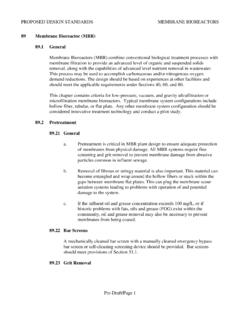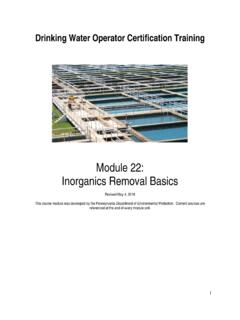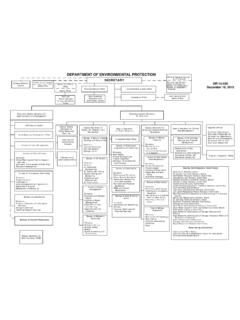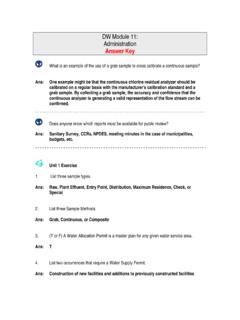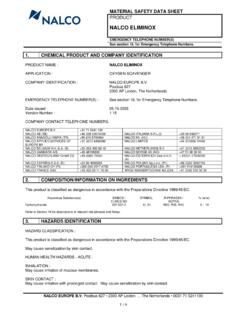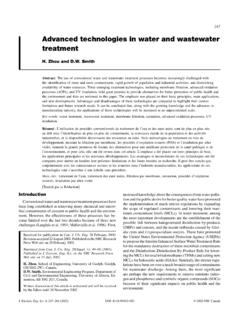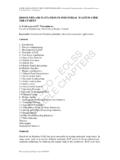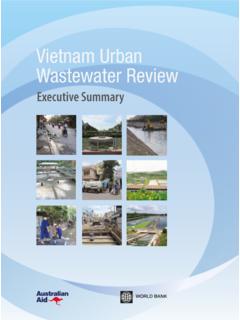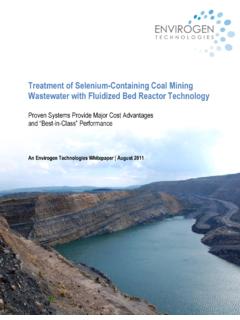Transcription of Module 5: Disinfection and Chlorination
1 wastewater treatment Plant Operator Certification Training Module 5: Disinfection and Chlorination Revised 2016. This course includes content developed by the Pennsylvania Department of Environmental Protection (Pa. DEP) in cooperation with the following contractors, subcontractors, or grantees: The Pennsylvania State Association of Township Supervisors (PSATS). Gannett Fleming, Inc. Dering Consulting Group Penn State Harrisburg Environmental Training Center Copyright 2016 Commonwealth of Pennsylvania, All Rights Reserved Module 5: Disinfection AND Chlorination . Topical Outline Unit 1 Disinfection and Chlorination Principles I. Purposes of Disinfection A. Basic Principles B. Common Pathogenic Illnesses C. Pathogen Removal II. Disinfectants and Chemistry A. Chlorination B. Elemental Chlorine (Cl2). C. Hypochlorite (OCl-). D. Chlorine Dioxide (ClO2). III. Chlorine Requirements A. Chlorine Demand B. Chlorine Residual C.
2 Establishing Dosages D. Breakpoint Chlorination E. Factors Influencing Disinfection IV. Application Point Unit 2 Chlorination Process Control I. Chlorinator Control Modes A. Manual B. Start-Stop C. Step-Rate Control D. Timed-Program Control E. Flow-Proportional Control F. Chlorine Residual Control G. Compound Loop Control Bureau of Safe Drinking Water, Department of Environmental Protection wastewater treatment Plant Operator Training i Module 5: Disinfection AND Chlorination . II. Measurement of Chlorine Residual A. Measurement of Chlorine Residual III. Use of Chlorination Control Nomograph A. Chlorination Control Nomograph B. Example Problems Unit 3 Chlorine Safety and Handling I. Safety Program A. Chlorine Hazards B. Personnel Safety and Protection C. First Aid II. Chlorine Handling A. Chlorine Containers III. Chlorine Leaks and Response A. Chlorine Leaks B. Response Unit 4 Chlorine Equipment and Maintenance I.
3 Gas Feed System A. Equipment B. Operation C. Maintenance D. Trouble Shooting II. Hypochlorinator A. Equipment B. Hypochlorite Generator III. Chlorine Dioxide Facility A. Chlorine Dioxide Generators Bureau of Safe Drinking Water, Department of Environmental Protection wastewater treatment Plant Operator Training ii Module 5: Disinfection AND Chlorination . Unit 5 Dechlorination I. Basic Principles II. Sulfur Compounds A. Sulfur Compounds B. Dechlorination Control C. Safety (Sulfur Dioxide). D. Safety Procedures and Response E. Emergency Safety Equipment F. Equipment Unit 6 Ultraviolet Radiation I. Alternative to Chlorination II. Types of UV Systems A. Low Pressure-Low Intensity B. Low Pressure-High Intensity C. Medium Pressure-High Intensity III. Disinfection Process A. Factors Influencing Effectiveness of UV. B. UV Control C. Safety D. Equipment Maintenance Bureau of Safe Drinking Water, Department of Environmental Protection wastewater treatment Plant Operator Training iii Unit 1 Disinfection and Chlorination Principles Learning Objectives State the purpose of disinfecting wastewater .
4 Identify the three different types of chlorine used to disinfect wastewater . Describe the breakpoint Chlorination curve. Identify alternate feed points and the use of Chlorination in wastewater treatment . Bureau of Safe Drinking Water, Department of Environmental Protection wastewater treatment Plant Operator Training 1-1. PURPOSES OF Disinfection . Basic Principles Disinfection is the process designed to kill or inactivate most microorganisms in wastewater , including essentially all pathogenic organisms. Contrast this to sterilization, which is the removal and destruction of all living microorganisms, including pathogenic and saprophytic bacteria, vegetative forms and spores. Pathogenic organisms are bacteria, viruses, or cysts that can cause disease in a host. Common Pathogenic Illnesses Bacterial Parasitic Salmonellosis Amoebic Dysentery Shigellosis Ascaris Typhoid Fever Giardiasis Cholera Cryptosporidium Paratyphoid Viral Bacillary Dysentery Polio Anthrax Infectious Hepatitis Pathogen Removal Pathogen removal is important in the treatment of wastewater since the final discharge goes to bodies of water that serve as: Public water supplies Recreational uses Irrigation supplies Bureau of Safe Drinking Water, Department of Environmental Protection wastewater treatment Plant Operator Training 1-2.
5 PURPOSES OF Disinfection . Pathogens may be removed by various treatment processes: treatment Process Microorganism Removal Type Screening 10-20% Physical Removal Grit Removal 10-25% Physical Removal Primary Sedimentation 25-75% Physical Removal Chemical Precipitation 40-80% Physical Removal Trickling Filters 90-95% Physical Removal Activated Sludge 90-98% Physical Removal Chlorination 98-99% Disinfection Other Disinfection treatment Processes: Ultraviolet Light Ozonation Sterilization Bureau of Safe Drinking Water, Department of Environmental Protection wastewater treatment Plant Operator Training 1-3. DISINFECTANTS AND CHEMISTRY. Chlorination Chlorine and its various forms are powerful oxidants that will kill or inactivate most pathogenic organism that are harmful to human and animal life. Chlorination is the most commonly used Disinfection process for wastewater treatment . Chlorination chemicals are relatively: Easy to obtain Economical Effective Easy to apply Typical forms of chlorine used in wastewater treatment are: Elemental chlorine Hypochlorite Chlorine Dioxide Elemental Chlorine (Cl2).
6 Elemental chlorine is either liquid or gaseous in form. Chlorine gas can be compressed to a point where it liquefies. Cylinders contain both liquid chlorine (approximately 85%) and gas chlorine (approximately 15%). Elemental chlorine is provided in liquid form and delivered in 150-pound cylinders and 1-ton containers. For very large plants, it may be delivered in tank cars. Its concentration is 100% available chlorine. Chlorine generally evaporates within its container and remains in the gaseous form. It is mixed with water prior to being introduced to the process flow stream. Under high demands, it may be removed from containers in liquid form and gasified in an evaporator prior to mixing with water. Liquid chlorine is a clear, amber colored liquid. Liquid chlorine rapidly vaporizes to gas when unpressurized. One volume of liquid yields approximately 460 volumes of gas. Leaking Cylinder Emergency Tip: If you determine you have a leak in a chlorine gas cylinder, position the cylinder so that the leak is on the top to release gas rather than liquid chlorine.
7 For example, if the leak is in the fusible plug, roll the ton container so that the plug is in the uppermost position. Bureau of Safe Drinking Water, Department of Environmental Protection wastewater treatment Plant Operator Training 1-4. DISINFECTANTS AND CHEMISTRY. Gaseous chlorine is a greenish yellow toxic gas. In its gaseous form, it is approximately times heavier than air. Chemistry: Chlorine gas, free chlorine, reacts with water to form hypochlorous and hydrochloric acids. Chlorine + Water Hypochlorous Acid + Hydrochloric Acid Cl2 + H2O HOCl + H+ Cl- In solutions that are dilute and have a pH above 4, the formation of HOCl (hypochlorous acid) is most complete and leaves little Cl2 existing. The hypochlorous acid is a weak acid and is very poorly dissociated (broken up) at levels below pH 6. Thus any free chlorine or hypochlorite ion (OCl-) added to water will immediately form either HOCL or OCl- and what will be formed is controlled by the pH value of the water.
8 This is extremely important since HOCL and OCl- differ in Disinfection ability. HOCl has a greater Disinfection potential than OCl- . Normally in wastewater with a pH of (depends on temperature), 50%. of the chlorine present will be in the form of HOCl and 50% in the form of OCl- . A higher pH level will result in a greater percent of OCl- . Distribution of HOCl and OCl- in Water 100 0. 90 10. 80 20. 70 30. 60 40. 50 50. 40 60. 30 70. 20 80. 10 90. 0 100. 456789 10 11. pH. Figure The Distribution of HOCl and OCl- in Water Bureau of Safe Drinking Water, Department of Environmental Protection wastewater treatment Plant Operator Training 1-5. DISINFECTANTS AND CHEMISTRY. Hypochlorite (OCl-). Hypochlorite may be provided in several forms: Sodium Hypochlorite It is acquired as a liquid in the form of sodium hypochlorite (NaOCl), which is bleach. It may be obtained in carboys, or bulk delivery. In this form it is available in concentrations of and 15%.
9 This is the general form of hypochlorite used in most wastewater treatment plants. It may also be generated on site from the electrolysis of salt, (NaCl). In this form it is available in concentrations of approximately to Sodium hypochlorite reacts with water to form hypochlorous acid and sodium hydroxide. Chemistry: Sodium Hypochlorite + Water Sodium Hydroxide + Hypochlorous Acid + Hypochlorite- +. Hydrogen+. 2 NaOCl + 2H2O 2 NaOH + HOCl + OCl- + H+. TIP: You don't need to memorize the chemical equations for the reactions of chlorine in water (more shown below). However, they provide a reference for you of the complete Chlorination process. Calcium Hypochlorite This chemical is available in granules, pellets, and powder. It may be delivered in cans, barrels, and drums. It must be mixed with water prior to its use. Concentrations may be prepared with 3% available chlorine. This chemical is also known as high test hypochlorite or HTH.
10 HTH contains a high concentration of chlorine - typically 65 to 70 The rest is calcium. Chemistry Calcium Hypochlorite + Water Calcium Hydroxide + Hypochlorous Acid Ca(OCl)2 + 2H2O Ca(OH)2 + 2 HOCl Bureau of Safe Drinking Water, Department of Environmental Protection wastewater treatment Plant Operator Training 1-6. DISINFECTANTS AND CHEMISTRY. Chlorine Dioxide (ClO2). Chlorine dioxide is a relatively unstable chemical and is manufactured at its point of use and introduced into the flow stream shortly thereafter. Chlorine dioxide is the result of a reaction between chlorine gas/water solution, and sodium chlorite. The reaction, under controlled conditions will result in a 2% solution having a theoretical available chlorine content of Sodium Chlorite + Chlorine Sodium Chloride + Chlorine Dioxide 2 NaClO2 + Cl2 2 NaCl + 2 ClO2. The subsequent reaction of the chlorine dioxide with water when introduced to the process flow stream results in the following reaction: Chlorine dioxide + Water Chlorate Ion + Chlorite Ion + Hydrogen Ion 2 ClO2 + H2O ClO3-+ ClO2-+2H+.

